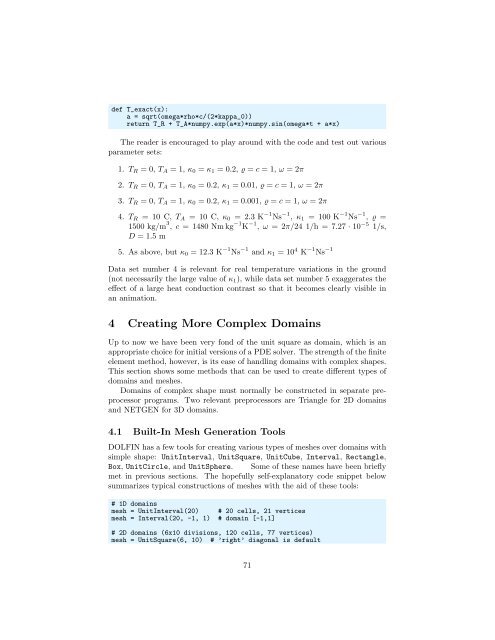A FEniCS Tutorial - FEniCS Project
A FEniCS Tutorial - FEniCS Project
A FEniCS Tutorial - FEniCS Project
Create successful ePaper yourself
Turn your PDF publications into a flip-book with our unique Google optimized e-Paper software.
def T_exact(x):<br />
a = sqrt(omega*rho*c/(2*kappa_0))<br />
return T_R + T_A*numpy.exp(a*x)*numpy.sin(omega*t + a*x)<br />
The reader is encouraged to play around with the code and test out various<br />
parameter sets:<br />
1. T R = 0, T A = 1, κ 0 = κ 1 = 0.2, ̺ = c = 1, ω = 2π<br />
2. T R = 0, T A = 1, κ 0 = 0.2, κ 1 = 0.01, ̺ = c = 1, ω = 2π<br />
3. T R = 0, T A = 1, κ 0 = 0.2, κ 1 = 0.001, ̺ = c = 1, ω = 2π<br />
4. T R = 10 C, T A = 10 C, κ 0 = 2.3 K −1 Ns −1 , κ 1 = 100 K −1 Ns −1 , ̺ =<br />
1500 kg/m 3 , c = 1480 Nmkg −1 K −1 , ω = 2π/24 1/h = 7.27 · 10 −5 1/s,<br />
D = 1.5 m<br />
5. As above, but κ 0 = 12.3 K −1 Ns −1 and κ 1 = 10 4 K −1 Ns −1<br />
Data set number 4 is relevant for real temperature variations in the ground<br />
(not necessarily the large value of κ 1 ), while data set number 5 exaggerates the<br />
effect of a large heat conduction contrast so that it becomes clearly visible in<br />
an animation.<br />
4 Creating More Complex Domains<br />
Up to now we have been very fond of the unit square as domain, which is an<br />
appropriate choice for initial versions of a PDE solver. The strength of the finite<br />
element method, however, is its ease of handling domains with complex shapes.<br />
This section shows some methods that can be used to create different types of<br />
domains and meshes.<br />
Domains of complex shape must normally be constructed in separate preprocessor<br />
programs. Two relevant preprocessors are Triangle for 2D domains<br />
and NETGEN for 3D domains.<br />
4.1 Built-In Mesh Generation Tools<br />
DOLFIN has a few tools for creating various types of meshes over domains with<br />
simple shape: UnitInterval, UnitSquare, UnitCube, Interval, Rectangle,<br />
Box, UnitCircle, and UnitSphere. Some of these names have been briefly<br />
met in previous sections. The hopefully self-explanatory code snippet below<br />
summarizes typical constructions of meshes with the aid of these tools:<br />
# 1D domains<br />
mesh = UnitInterval(20) # 20 cells, 21 vertices<br />
mesh = Interval(20, -1, 1) # domain [-1,1]<br />
# 2D domains (6x10 divisions, 120 cells, 77 vertices)<br />
mesh = UnitSquare(6, 10) # ’right’ diagonal is default<br />
71

















